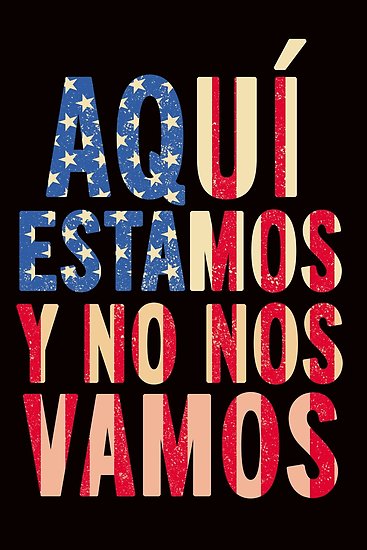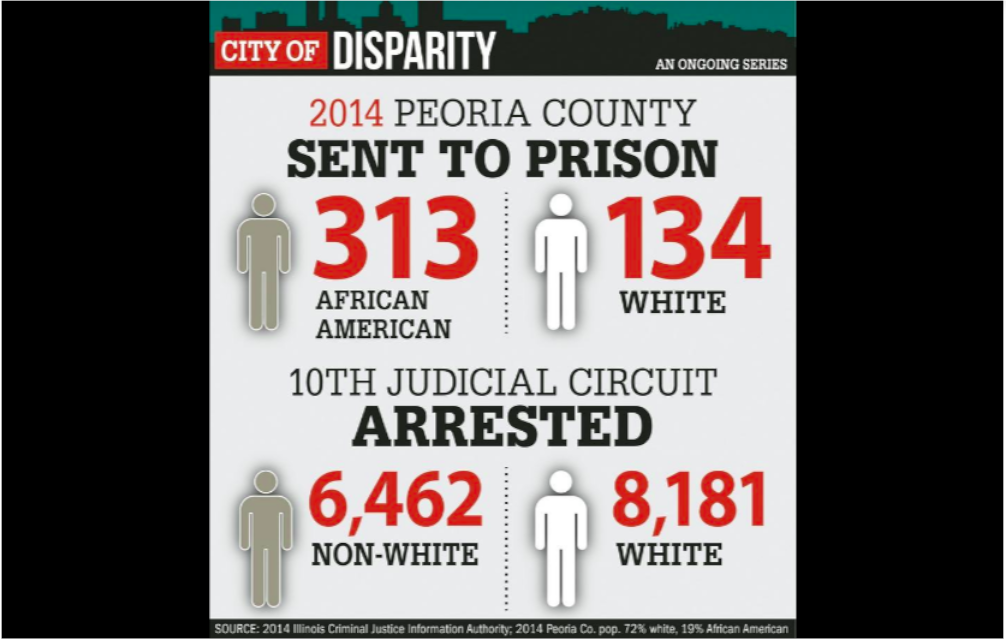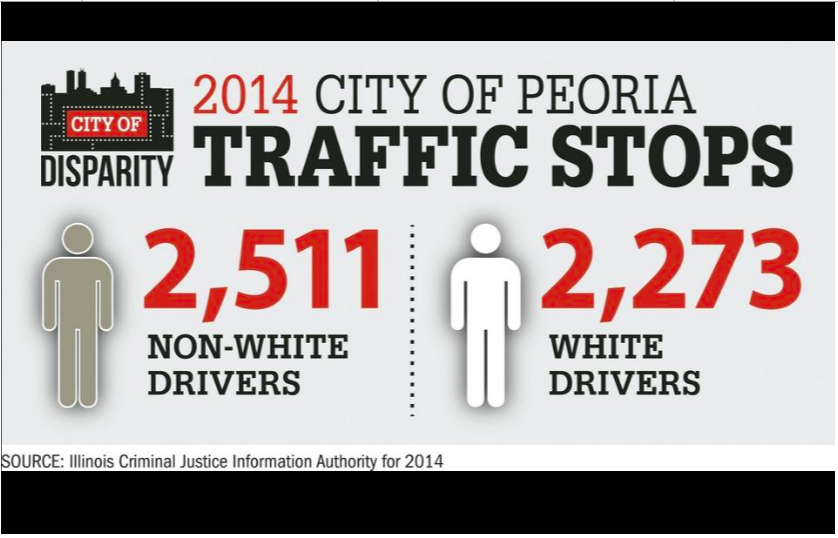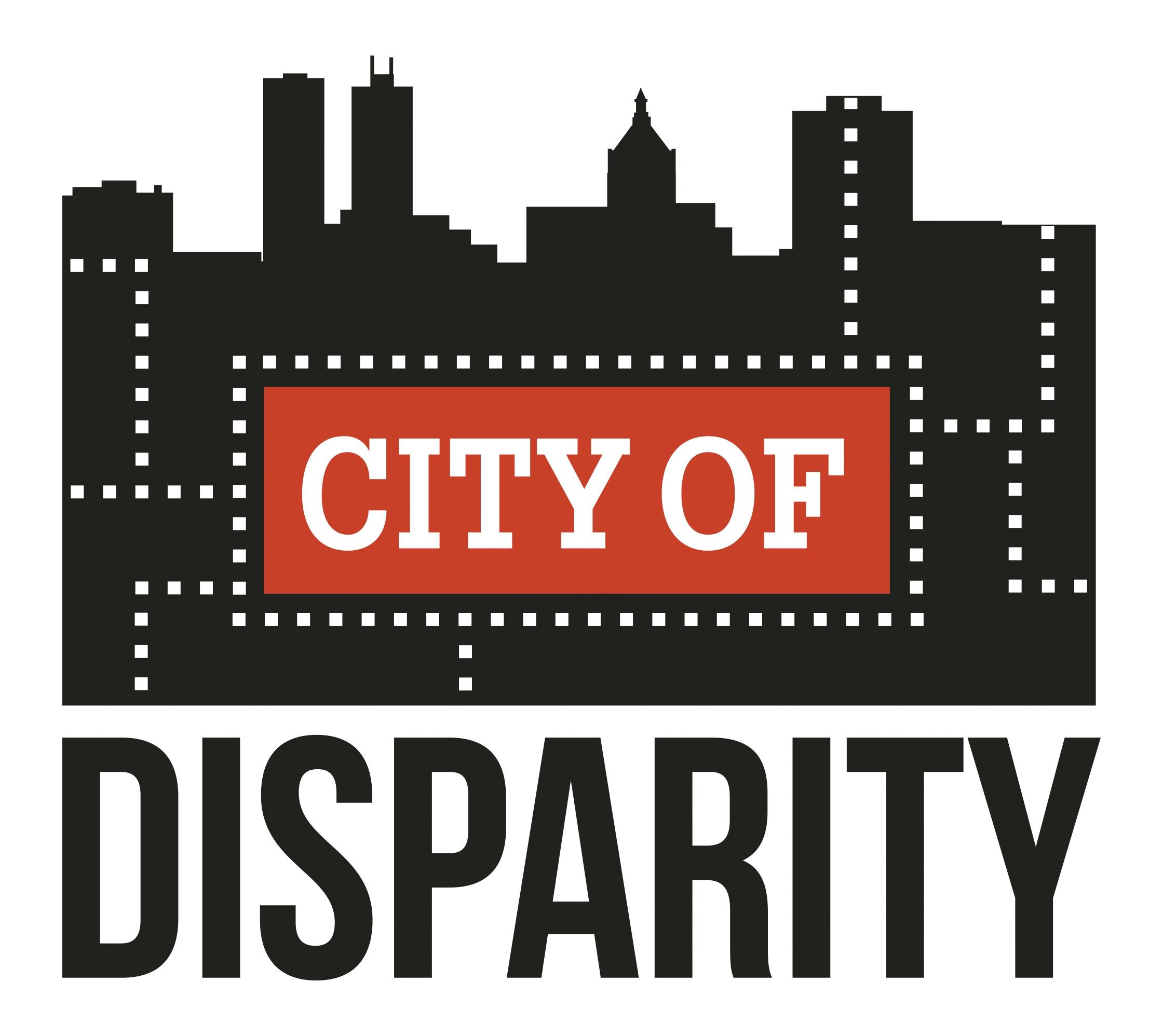Does Systemic Racism Play in Peoria Part 3
No discussion of systemic racism would be complete without including the experiences of non-white people of color. We must also analyze how migration has changed the racial makeup of towns like Peoria while also reflecting on the close positionality of racist & xenophobic institutions and policies. Unless you trace your descent to Native Americans, African-Americans, or refugees, you are descended from immigrants and live in an immigrant nation. A major factor in the growth and strength of the U.S. is its status as an immigrant nation; immigration in this country has always been a net-positive for society. In response of anti-immigrant rhetoric that attempts to stress the issue of illegal immigration, until quite recently it was significantly easier to immigrate to America and become a citizen compared to now with our current byzantine and overly draconian system. Despite these facts, throughout American history there has also been a strong trend of xenophobia grounded in a nativist & assimilationist ideology. It has waxed and waned depending on a multiplicity of factors: economic strength, race relations, foreign policy, etc. Currently, we are seeing a particularly virulent strain of xenophobia with the election of Donald Trump and the manufacturing of a mass deportation machine over the last 3 decades from both Democrat & Republican administrations.
Anti-immigrant hate has reached a fever pitch in the U.S. (and, throughout the Western world as we witness the regrowth of fascist ideologies). Trump began his campaign from the ivory pillar of his over-mortgaged hedonism-tower literally referring to the majority of immigrants crossing the Southern border as “rapists & murderers”, even going so far as to accuse Mexico of a conspiracy to send its criminals here to weaken us. His campaign promise of a physical wall on the Southern border of the U.S. has served to fetishize the desire for fascism, the desire to other a human until their humanity is so obscured as to be unrecognizable. This desire to Otherize–a desire to inflict pain–is the only way the fascists and reactionaries can logically deny that the overcrowded, under-resourced, and painfully inhumane living conditions at immigrant concentration camps are anything but the human rights crimes most realize them to be.
An estimated 8,792 people in Peoria are foreign born, mostly from Mexico and India. Nearly 1 in 7 Illinoisans are immigrants (foreign-born), and almost half of them are naturalized U.S. citizens who are eligible to vote. Roughly 886,000 Illinois residents has one relative who is undocumented living with them. About 799,000 (90%) of those mixed-status households also include a family member who is a U.S. citizen or has lawful immigration status. According to data from the Illinois Coalition for Immigrant and Refugee Rights (ICIRR), Metropolitan Peoria has roughly 5,792 documented immigrants and approximately 3,000 undocumented immigrants; about half of the undocumented population emigrated from Latin America (mainly Mexico), and the other half from Asia. “As of 2017, 8.26% of Peoria, IL residents (9.54k people) were born outside of the United States, which is lower than the national average of 13.7%.”1 The majority of documented immigrants in Peoria hail from Mexico, India, and Germany in that order.
. . .
In 2017, I and other like-minded citizen-allies formed the immigrant justice group Peoria No Ban No Wall. We immediately began reaching out to members of the Latinx, Muslim, and other immigration communities to see what were the needs of the community and how could we as allies best help them.

Thankfully, Peoria has not seen any deportations, to the best of our knowledge. Yet, the fear of deportation and anti-immigrant or Islamophobic violence continues to be present. Trump’s policies of frequently changing immigration policies, becoming more draconian in enforcement, and going after literally everyone–undocumented or not–has resulted in a heightened sense of uncertainty about people’s statuses. Even naturalized citizens, like local activist Jimena Lopez, have experienced anxiety because of the Trump administrations threats to begin denaturalization proceedings against people who are already citizens.
Peoria No Ban No Wall partnered with the legal-aid group The Immigration Project and hosted several Know Your Rights workshops in immigrant communities. The Immigration Project is the only non-profit immigrant legal aid group in all of downstate Illinois. We provided up-to-date information on the ever-changing policies of immigration law, provided resources, and educated people on their rights when interacting with law enforcement. We even had the privilege of providing a workshop for the Methodist Mid-West Hispanic Caucus hosted at First United Methodist Church in Peoria. This potentially had the ability to educate thousands of immigrants across the midwestern United States.
Another major concern was addressing some of the trauma immigrant children were facing because of the fear their parents may be deported. “David del Pozo teaches English as a Second Language at Glen Oak Primary School. He says many students in his classroom are confronting anxiety that makes learning difficult, if not impossible. ‘They are afraid that you know some day, somebody would come to school, and they could be deported, or something could happen to them,’ Del Pozo said. ‘They could be separated from their families…’”2 District 150 superintendent Dr. Kherat stated she was aware of some students not attending school because of fears of deportations or hate crimes. Peoria No Ban No Wall launched a successful lobbying campaign with the help of ICIRR to pass a Safe Haven policy at Peoria Public School’s District 150. After nearly six months of negotiating, the District 150 School Board unanimously passed a Safe Haven resolution. This limited the kinds of information shared between the school district and immigration enforcement, and essentially barred access to schools by Immigration & Customs Enforcement. During consideration of this issue, School Board member Dr. Davison-Aviles gave a personal reason this issue was so important to him:
“For some of us, this issue is a personal issue. I remember a story… of a single woman, from Mexico, and she had two children. And she was fleeing domestic violence; exactly the sort of person the current administration would seek to prevent from coming into the United States, because of course they’re not the right kind of citizen. However, this person persevered and actually did make it here – you’d be pleased to know; I’m sorry if I get a little emotional here… because, you see, if she hadn’t made it, I wouldn’t be here; nor would there be my brothers & sisters: attorneys, vice-presidents, and a pretty damn good auto mechanic. None of us would be here. That’s all I have to say.”

You can read the full policy written by myself and attorneys at ICIRR that was adopted by Peoria Public Schools here. “’District 150 showed real leadership, in an otherwise leaderless state,’ Zach Gittrich of Peoria No Ban No Wall said after board members unanimously approved a Safe Haven resolution. ‘They set a standard for the city, the county and the state.’”3
Peoria No Ban No Wall also built a relationship with Peoria Federation of Teachers Local 780. We provided them training and info on handling immigration issues in the classroom. Furthermore, we co-organized an event for May Day 2017 with the local teachers union entitled “Build Schools, Not Walls.” We had over hundred union members and immigrants there and uplifted the voices of immigrant students facing discrimination.
. . .
Unfortunately, not all of our strategies for immigration justice were successful, and it shown a spotlight on the reactionary politics that plague Peoria. Working with ICIRR, The Immigration Project, Illinois Peoples Action (IPA), Pastor Adrian Garcia of First United Methodist Church, and others, Peoria No Ban No Wall began the arduous process of lobbying Peoria City Council to pass a Welcoming Ordinance4 protecting Peoria’s immigrant residents in the Spring of 2017. Despite initial support from At-Large council person Beth Jensen and 2nd District Councilperson Chuck Grayeb, we quickly realized it would be an uphill battle. Unlike the District 150 school board, most of the council had no interest in addressing this issue, especially with spurious statements by President Trump about sanctioning “Sanctuary Cities.” One of the poverties of thought in Peoria is the ability to envision goals proactively; instead, Peoria is typically reactive and much to its detriment.
For a City Council that is constantly complaining about the population loss of Peoria (and Illinois in general) and its effect of a dwindling tax base, city council members considered the possibility of welcoming new migrants with supportive policies as anathema to its goals. Peoria has lost over 10,500 residents since 2010, more than any other downstate Illinois city, and it ranks 350th of 383 cities in the nation ranked by population growth.5 It ranks 5th in the nation for population loss of metropolitan areas. Of the population loss, 43% is domestic migration, i.e., people packing up and moving out to a different region in the U.S.6 The one group that added to Peoria’s population: international migration. From 2016-2017, the immigrant population of Peoria increased from 7.76% of the population to 8.26%.7 It’s almost common sense that making policies that protect immigrants would increase the amount of immigrants who want to live there.
But, the reactionary myopia of Peoria City Council is blind to these facts. Beth Akeson thought Welcoming policies would lead to higher crime. Alleged servant-leader Zach Oyler couldn’t comprehend why the city should even care: “I think this is a state or national concern.” Canadian immigrant Denis Cyr (who received an Einstein visa8 for his hockey prowess) couldn’t fathom the idea that poorer, less privileged immigrants might do whatever it takes to provide for their families. According to Latinx activist Cesar Vargas, conservative Jim Montelongo had no problem showing off his immigrant heritage when it came to getting elected but was no where to be found in the Latinx community after the polls closed. Mayor Ardis privately told immigration activists he personally had no problem with undocumented immigrants even saying we should let them all stay, but politically he was too cowardly to support the issue.
Studies demonstrate that crime is significantly lower in sanctuary jurisdictions. On average, there are 35.5 fewer crimes per 10,000 people in sanctuary counties. Economies are also stronger in sanctuary jurisdictions. Median household income, on average, is $4,352 higher in sanctuary jurisdictions. The percentage of people who live at or below the federal poverty line is, on average, 2.3 percent lower in sanctuary counties. Moreover, white poverty is, on average, 1.4 percent lower in sanctuary counties, and Latino poverty is, on average, 2.9 percent lower in sanctuary counties. Studies also show a 2.6% drop in households that receive SNAP benefits. Labor force participation is 2.5% higher in sanctuary counties and unemployment is 1.1% lower.9
As time progressed, other organizations like the ACLU of Peoria and Change Peoria got involved, and a loose coalition was formed for the purpose of turning Peoria into a Welcoming City. The ACLU of Peoria, under the direction of president Jeff Johnson, attempted to get a version of the Welcoming Ordinance approved by the Advisory Committee on Police-Community Relations with the help of then-Vice-President of the committee, Reverend Marcus Fogliano. Fogliano claimed that the Advisory Committee could pass legislation or recommendations that would then be placed directly onto City Council’s agenda for consideration (this turned out to be false, as the Committee has no such power10). The logic was, since the Ordinance largely focused on police interactions with immigrants, this committee’s recommendation would provide ample weight in convincing the already recalcitrant City Council.11
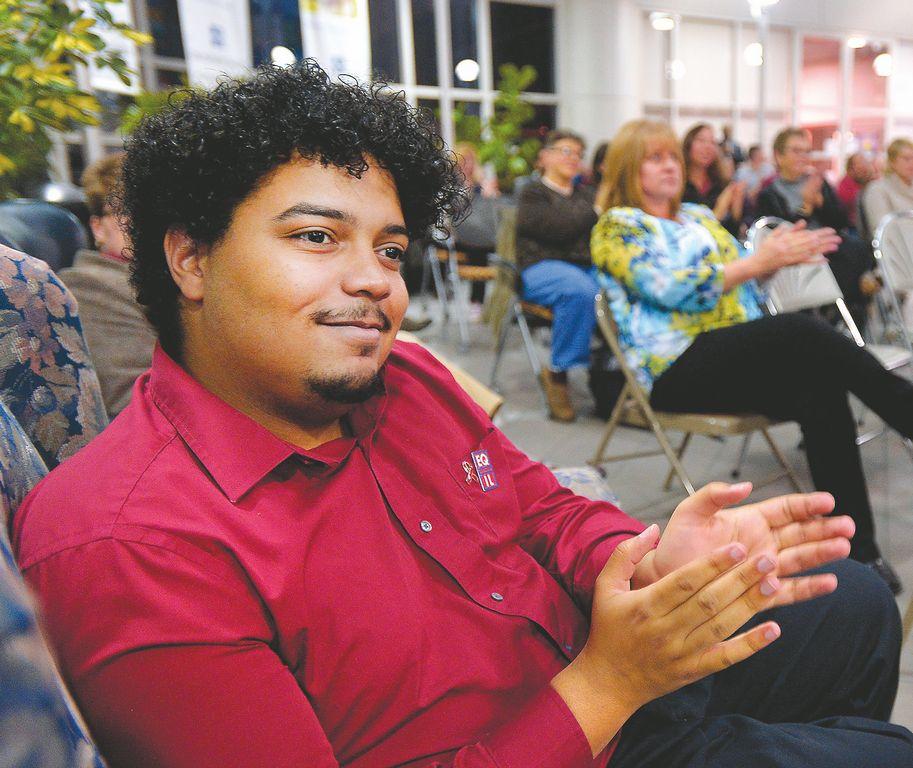
While there was certainly some support among the unelected members of the committee, there was also opposition. The fiercest opposition came from NAACP board member12 Don Jackson. He was initially confused as to why the ordinance was even being considered by this committee. Jackson even went so far as advocating for the police to racially profile Latinx residents and ask them to prove their documentation status. For a civil rights attorney who led the local NAACP for 21 years, his comments on the Advisory Committee sounded less like Dr. King and more like Sheriff Joe Arpiao.

At a NAACP of Peoria meeting I attended, Mr. Jackson recounted how he had visited a construction site to verify they were meeting minority employment quotas. When Jackson asked the foreman about this, the foreman pointed to a Latinx man and said, “There’s your minority.” Visibly disappointed, Jackson told the meeting he didn’t check to see if the Latinx individual was “illegal or not.” (Apparently, Mr. Jackson is unaware that many Latinx people are actually citizens.)
Current At-Large Councilmember Dr. Rita Ali served on the committee as its president during this time.13 Initially supportive of the measure, Dr. Ali eventually seemed flabbergasted by the complexity of the ordinance. Many different activists offered to personally review the ordinance with her, even presenting a willingness to bring expert immigration attorneys in to explain the finer details. When the committee finally voted on whether to recommend the ordinance or not,14 it was voted down in a tie-vote. Dr. Ali abstained from voting meaning it could have passed had she voted for it. Later, during her 2019 campaign for City Council, she said she couldn’t support the bill because of certain particulars in the ordinance (though she never did reveal what these particulars were).
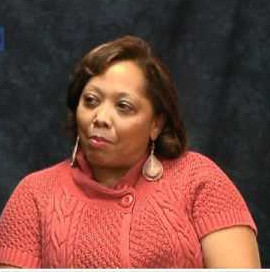
The NAACP of Peoria never made a public decision on whether to support the Welcoming Ordinance, despite the National NAACP supporting Welcoming
policies.15 At the same time, neither of the African-Americans on City Council (District 1’s Denise Moore and then-At-Large member Eric Turner) expressed any support either. There seems to be this belief among the more conservative members of the Black Establishment that immigrants, especially low-skilled Latinx workers, negatively impacts the employment opportunities of Black Americans. It’s a rather protectionist stance to civil rights. “Positioning one group of low-wage workers against another group of low-wage workers is an insidiously effective method of fomenting resentment and tensions among workers of different racial and ethnic backgrounds, which only buttresses the status quo.”16
The hypothesis that an increase in immigrant labor depresses wages and opportunities for African-Americans is belied by the fact that population growth stimulates economies precisely because an increase in consumers generates a stronger economy:
A 2016 study conducted by scholars at Penn’s Wharton School of Business found that the increase in the labor supply resulting from immigration could actually generate more employment in industries such as home construction and food production. More people means more consumption, and, specifically, more consumption by the working poor. Existing data simply doesn’t support any definitive correlation between the stark unemployment rate of African Americans and the employment of recent immigrants. Nevertheless, those striving to push through xenophobic, racist, Islamophobic, and inhumane immigration restrictions find unusual allies among some African Americans seeking to lower the black unemployment rate.”17
Furthermore, this myth undermines the achievements and opportunities for solidarity of the many immigrants hailing from the Caribbean and Africa, over 200 of which live in the Peoria area.
This is not to say the NAACP of Peoria supports Trump’s immigration policies; they’ve spoken and been present at local rallies against child separation and inhumane immigration policies. Nor is it suggesting the entire black community shares this skepticism for increased immigration. The black community is not monolithic (no community is). The Black Justice Project in Peoria (a group of younger, more progressive black activists) has expressed support for Welcoming Policies. This is merely an attempt to analyze the problematic nature of this particular myth.
PPD currently has a policy against collaborating with ICE, but its merely a department policy not a statute enforced by law. This policy could easily change with new leadership or if different circumstances arise. While At-Large candidate Andre Allen said publicly during his campaign that he remained on the fence about Welcoming Policies, Allen made the excellent point that in his career as a college administrator at Methodist College he found that concrete written policies are better than ad-hoc or informal policies. “I’ve been bitten by not having policies that are clear and enforceable,” Allen said.
Yet, the myopic poverty of City Council is unconcerned about this. Beth Jensen even had a change of heart about her support, trotting out right-wing propaganda about the risk of “Sanctuary Cities” loosing Federal funding.18
Jensen was even given the opportunity to share immigrant testimonials from Peoria immigrants who supported the Welcoming Ordinance.19 She could have used her privilege & power to uplift these oppressed voices, but she chose against this, saying these testimonials did not show people under imminent threat of deportation. Talk about reactive and regressive thinking. The whole point of the Welcoming Ordinance was to be proactive in case the Federal government began immigration actions in Peoria. (For more on Beth Jenson’s flip-flopping, see my article).
While Peoria did pass a resolution declaring itself a Welcoming City in May of 2017, resolutions are merely statements with no force of law. As At-Large City Council candidate Peter Kobak said, “We [City of Peoria] passed a resolution, but it doesn’t really protect anyone. We don’t have an institution to protect those immigrants.” Nor are activists confident that any of the members of City Council would take appropriate action action should concerns arise. Ultimately, it was clear to some activists that the resolution was a tactical maneuver by City Hall to undermine the movement for a Welcoming Ordinance by declaring they’d solved the problem without ever creating any real policy.
. . .
In Illinois in general, there have been other struggles for the immigrant community. In February of 2019, immigrant justice activists became aware of a lobbying effort by a private prison corporation, Immigration Centers of America, to build a privately-run immigrant detention center in Dwight, IL. The overwhelming majority of privately-operated prisons are immigrant detention centers. This was of great concern to immigrant justice activists from across the state. An immigrant prison so close to other Illinois communities could possibly increase the ICE traffic in our own communities. Activists from across the state–and some from beyond–descended on Dwight, IL several times protesting against the construction of an immigrant detention center. Groups included: #NoICEDwight, Peoria No Ban No Wall, the Immigration Project, IPA, ICIRR, Connect Kankakee, Peoria and Blono Democratic Socialist of America, Deportation Watch Network, Catholic Legal Immigration Network, and many more. We held several rallies and marched through the streets of Dwight, IL with several hundred activists.
Unfortunately, the Dwight Board of Trustees approved the construction of the immigration detention center by a vote of 5-2. Disappointed but not defeated #NoICEDwight activists quickly took their fight to the State Capital in Springfield. Groups successfully lobbied the Illinois legislature to pass HB 2040, a bill aimed at banning privately-operated immigrant prisons from operating within Illinois. Governor Pritzker signed the bill into law on June 21st, 2019. This was a huge victory for immigrants across Illinois and beyond. But, the struggle isn’t over. HB 2040 didn’t outlaw local jails contracting with federal government to imprison immigrants. Pulaski County, McHenry County, and Kankakee County all house immigrants in their jails and profit off of the misery of our draconian immigration system. (You can read more about the situation in Dwight, IL here.)
. . .
Immigrant residents in Peoria have also experienced acts of discrimination and fear based on the documentation status of themselves or family members. Dr. Auria Toxqui is an assistant professor of History at Bradley University. She was born in Mexico City. She is currently a legal permanent residence who has lived in the Peoria area for the past ten years. Dr. Toxqui has had mainly positive experiences and loves her community in Peoria.
However, since the rise of Trump, she’s experienced more discriminatory behavior from private citizens. Once she was in a local grocery store with her 1-year-old daughter. She was talking with her daughter, like all parents do, while she was shopping. Because Dr. Toxqui is bi-lingual, she is raising her daughter to be bi-lingual and frequently speaks to her in Spanish. Someone randomly launched an inquisition asking if Dr. Toxqui taught her daughter English. This is not the first time this has happened to the professor, and despite being dismayed, she responded “there was no official language prescribed in the U.S. constitution” followed by a bevy of statistics showing Latinx children are more likely to be multi-lingual than white children.
But, it wasn’t until she faced a particularly glaring experience that she began to notice Peoria shifting from being “a friendly to a non-friendly city.” On the 4th of July 2017, Dr. Toxqui and her family were enjoying a baseball game at Dozer Park. While she sat with her 2-year-old daughter watching the game, a rude woman yelled “Mexican, Mexican!” while giving the professor and her daughter a middle finger. It took her several days to realize this incident was a racist attack against her.
. . .
There is still much struggle to be done to help the immigrant community in Peoria. There are thriving Latinx, Hindu, and Muslim communities growing in Peoria despite the Great Recession and thirty years of a draconian immigration policy.
In Part 4, we will look at attempts to reduce racial inequity by both government and private interests in the Peoria Area. What has been accomplished? What still needs to be done? Included: an interview with Peoria County States Attorney candidate Chris McCall on his vision for Peoria County. Plus, additional fragments.
For more Fragments on Playing in Peoria, see here.
Does Systemic Racism Play in Peoria Part 2
Police are almost synonymous with oppression against people of color. Modern policing finds its origins in the slave patrols of the antebellum South after all… Back in the 1960s, Peoria had two kinds of justice: the official criminal justice dispensed through court and river justice. What’s river justice, you may ask? If you were someone the police didn’t like, they’d take you down to the Illinois river and just throw you in advising you of your right not return to Peoria.
. . .
Governing magazine points to a new tradition in Peoria around nuisance ordinances and the discriminatory ways the Peoria Police Department enforces the ordinance.
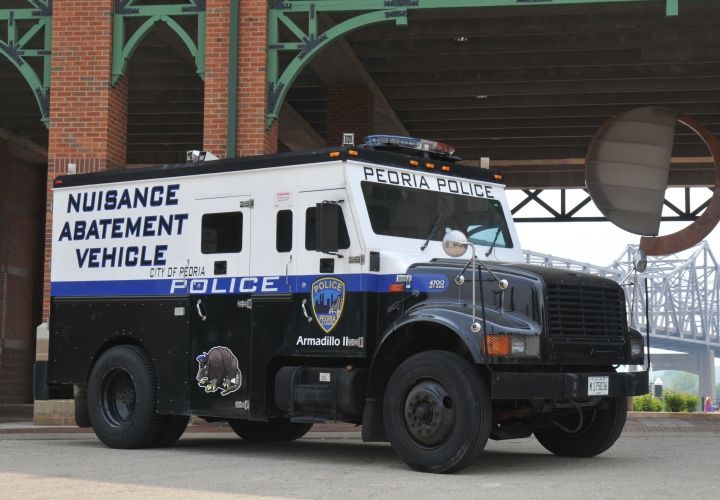
In Peoria, the police department calls the aging armored truck parked on the city’s southwest side an “armadillo.” The police see it as a symbol of law and order in neighborhoods that have had to endure chronic nuisances and frequent minor crimes. But fair housing advocates see the truck far differently: as a symbol of indiscriminate police power used disproportionately in black neighborhoods to kick people out of their homes…
Governing
But while the armadillos became symbols of smart policing in many circles, to fair housing advocates they became a symbol of something else: the discriminatory way that the city of Peoria responds to nuisance violations.
The Hope Fair Housing Center, a nonprofit group based in Chicago’s suburbs, sued the city of Peoria in 2017 over the way it handles nuisance violations. “The armadillos, like the nuisance ordinance, are deployed at the request of political officials and well-connected local residents rather than pursuant to objective criteria,” the group alleged in its lawsuit. “These deployments are made primarily in predominantly African-American neighborhoods…
The lawsuit claims that the police force doesn’t treat all alleged violators the same. The job falls to a small team within the police department, and it has few rules to follow and little oversight. In three years, the city issued just 148 nuisance citations, HOPE’s attorneys wrote, even though records of police calls indicate that as many as 12,000 properties could have been cited under the nuisance ordinance. More than 70 percent of the nuisance citations that the city did issue were in black neighborhoods, even though blacks made up only 27 percent of the [City of Peoria] population. A map included with the lawsuit shows that police posted armadillos almost exclusively in areas with significant black populations.
As in many African-American communities in the U.S., relations are particular fraught with the local police. Despite the black population being nearly 30% of the City’s population, only 14% of Peoria Police Officers are black…17
According to At-Large Councilmember Dr. Rita Ali, nearly 90% of PPD’s officers live outside the City of Peoria…
East Bluff Activist Jessie McGown Jr. says police officers are largely unwilling to participate in community events and most PPD officers have very little knowledge of the people living in the community or even what is happening in the community.20 McGown points to examples like former PPD officer Jeremy Layman. Layman posted several “controversial” Facebook posts, including an image of a shirt entitled “Baby Daddy Removal Team.” Layman was later terminated because of the posts but is currently suing the City of Peoria for wrongful termination.
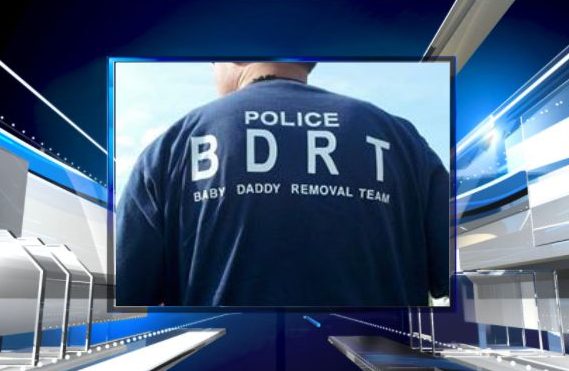
McGown also made the example of an unnamed police officer expressing relief that a black member of the community was murdered with McGown claiming the officer stated, “That’s another one we don’t have to worry about.” He says there is no trust from the black community towards the police and vice-versa. “The captains and chiefs are game [when it comes to spending time in the black community], but the rank-and-file will tell you in a heartbeat ‘they aren’t going to do that.’ I’ve been told that several times [by officers].”21
It’s not hard to see why many in the black community are particularly reticent when it comes to interacting and trusting PPD. Traffic stop data from 2014 shows PPD stopped 2,511 non-white drivers compared to 2,273 white drivers. Traffic stops are generally the most common way individuals interact with the law enforcement. It is well-known police officers often look for ways to pull a person over in what are referred to as pretext stops. Officers will use a pretext like a broken tail light or failure to signal as a pretext to stop a car and search it if possible, often with no probable cause available.
.
According to a 2016 study also entitled “Does Systemic Racism Play in Peoria,” performed by researchers at University of Illinois:
The data collected showed that traffic stop rates have throughout time had inconsistencies in regards to percent blacks being stopped compared to the population. These inconsistencies are not explained by zip code data, which shows that these inconsistencies remained true across all zip codes making up the city of Peoria. In addition, black people were more likely to be searched but less likely to have contraband on their person. And if they were found with drugs, it was less amount than typically found on white citizens. This disparity hits black males the most between 20 to 40 years of age.22
Another source of the division between police and the black community is PPD’s style of policing. Peoria started a much publicized “Don’t Shoot” Program based off the book Don’t Shoot: one man a street fellowship, and the end of violence in inner-city America by David M. Kennedy. The program is largely grounded in the Broken Windows Policing method which when “applied to police tactics, brings attention towards the removal of visible signs of social disorder,”23 though Kennedy denies any connection. According to internationally renowned sociologist & ethnologist Loïc Wacquant, broken windows policing “postulates that the immediate & stern repression of the slightest… nuisance on the streets stems the onset of major criminal offenses by (re)establishing a healthy climate of order.”24 Reasserting order with a draconian zeal will stem major crimes, the theory goes. PPD’s own description of the program from 2012 seems to correspond to this definition despite claims to the contrary:
It’s an aggressive multi-strategy anti-gang and anti-gun violence program designed to decrease shootings and get the most dangerous criminals off the streets… The centerpiece of the program is a focused deterrence strategy enhanced by an innovative community-wide education and outreach program crafted to thoroughly incorporate all segments of the citizenry of the Greater Peoria area. Using offender-based policing strategies, police and prosecutors send a specific message to a number of high-risk individuals that gun violence will not be tolerated.
But, over three decades of criminology data debunks the efficacy of Broken Windows Theory:25
“Studies show that the programs [of Broken Windows] do not work at all and claim that success headlines often use the decreasing crime rate as a sign that the program worked when in fact crime was decreasing before the program started. According to the Don’t Shoot program’s own data this may be the case for Peoria as well.”26
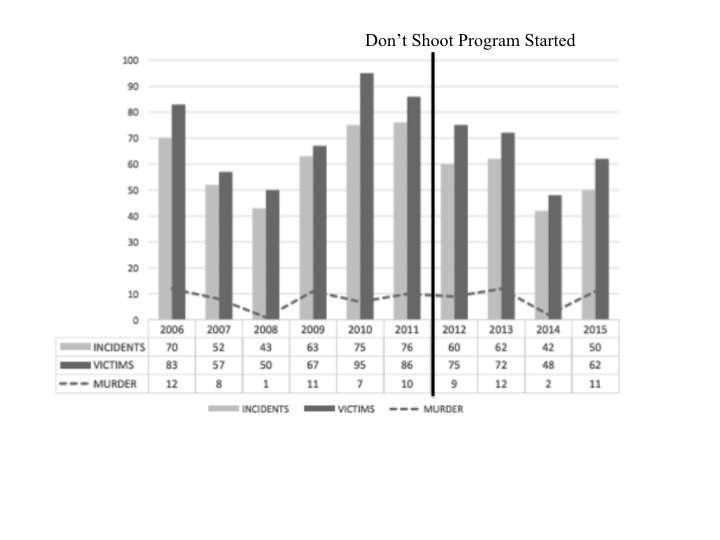
“Don’t Shoot” was started in 2012, two years after there was already a downward trend in shooting crime.
. . .
In prosecutions, black residents are clearly at a disproportionate disadvantage. According to NAACP member and journalist Sherry Cannon, “68.5% of all people sentenced to prison from Peoria County were Black, even though African Americans are only 19% of Peoria County.”27 Furthermore, “African Americans are 2.4% more likely to be respondents or defendants in every courtroom in Peoria County,” and black residents face more fines and fees from local government than any other jurisdiction in the nation save Ferguson, MO.28 Back in 2014, Peoria County sent 313 African-Americans to prison compared to 134 whites. At the same time, 6,642 non-whites were arrested in Peoria County, compared to 8,181 whites. Remember, blacks make up less than 20% of the county’s residents, while whites are 73%.
. . .
Beyond the raw statistics, there are striking examples of the differences in the way whites and blacks are treated for alleged crimes by the Peoria County States Attorney and PPD:
In 2013, a 17-year old Yunek Moore was brutally assaulted by PPD at a graduation party. There were no drugs or alcohol present, but the police responded to noise complaints from neighbors. Yunek had just graduated Peoria High School. She was president of her class, college-bound, and a National Honor Role member. She is also African-American:
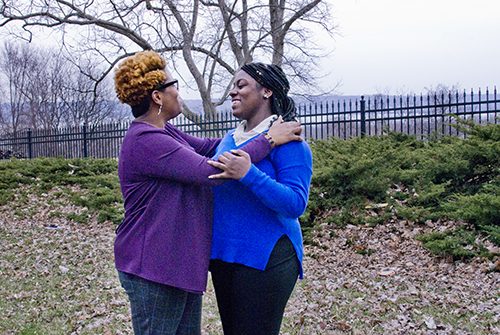
“Recounting the evening of the arrest, Yunek said someone shone a flashlight in her eyes and demanded her ID. She asked why. She thought someone was joking with her. The same demand was made again, and she responded the same way. Others at the party that evening confirmed the police did not identify themselves.”29
When the unidentified police–essentially trespassing on private property at this point–didn’t get the response they wanted, they proceeded to escalate with violence. “According to three witnesses, Yunek was yanked from her seat, dragged from the backyard with a twisted wrist technique and slammed into a garage wall.”30 She was arrested and taken to Peoria County Jail under spurious charges of resisting arrest. She was found guilty after a bench trial and placed on 12 months of court supervision. The injuries sustained were serious enough that Yunek had to have multiple surgeries costing her over $113,000 in medical expenses. Yunek has tried twice unsuccessfully to get accountability from the City of Peoria. Both times, juries were deadlocked in civil trial. The city has yet to take personal responsibility for their actions.
But, when it was a white man who fell victim to the authoritarian/triggered sentiments of Mayor Ardis (during the infamous #TwitterGate scandal), the city eventually shelled out a half-million settlement (and rightfully so).
. . .
Sherry Cannon recounts the circumstances of Amanda J. Boyer. During the infamous polar vortex in January 2019, Boyer was driving down Farmington Road when she fatally struck pedestrian John I. Lackey. Boyer fled the scene but was eventually arrested and ultimately plead guilty; she faced up to fifteen years in prison. Boyer ended up being sentenced to less than three months. “Judge Kevin Lyons sentenced her to 75 days in the county jail. His explanation for not giving her a harsher sentence was, “she is not penitentiary material”.”31 Cannon asks, “Who is penitentiary material?”
Yet, the same Kevin Lyons, when he was States Attorney for Peoria County32 charged a 15 year old boy, Dione Alexander, with aggravated battery with a firearm and received a conviction of 24 years. Despite shooting at a specific student Dione had feuded with in the past and shooting into a crowded hallway at Woodruff High School, no one was killed or injured in the incident.33 The 3rd appellate court of Illinois overturned the ruling saying it left no room for rehabilitation efforts considering Dione was a juvenile at the time. He was later released after serving 6 years in prison. Kevin Lyons threatened to appeal the ruling.
. . .
In another instance of Peoria justice, Brock Ardis, a white man and the nephew of Peoria’s mayor, Jim Ardis, shot up Crusens bar on Farmington, hitting “an individual in the shoulder and hand,” essentially committing attempted murder, yet “the charges were reduced, by the Peoria County States Attorney [Jerry Brady], from aggravated battery to reckless firing of a handgun, allowing him to avoid penitentiary time.”34 Brock Ardis was noted to comment under Facebook posts regarding this incident.
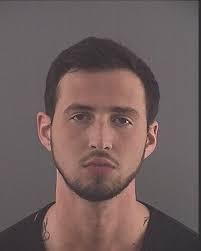
. . .
Currently, a 14-year old boy, Zaveon Marks, is facing multiple first degree murder charges in adult court for the death of 16-year old Zarious Fair. Zaveon allegedly murdered Zarious after a failed armed robbery. The question of whether to charge Zaveon as an adult or not reached the court system several times. Juvenile Court Judge Judge Frank Ierulli said “that he found no reason to keep Zaveon Mark’s case within the juvenile system, and that he didn’t think the boy was a “naive young man.””35 Furthernore, Judge Ierulli, said “This kid is street smart and savvy, he knows what to do and when to do it.”36 The judge even went so far as to recognize the boy’s poise, saying the child could clearly control his actions, with the implication seeming to be he acted more mature than the average 14-year old child.37 This despite a great deal of research showing that the brains of juveniles are significantly underdeveloped compared to adults, reducing the culpability of juveniles who commit such crimes.38 (This is certainly not to claim that juveniles should not be punished for serious crimes. If Zaveon is found guilty, he should be punished but the focus should be on rehabilitation and the requirement he pay significant restitution to Zarious Fair’s family. You can read my article about this case here.)

. . .
In April of 2019, a woman named Tina Gray was at a storage unit on Farmington Road. Shortly after arriving, an elderly white man named Jack Anderson showed up on the scene. He quickly began harassing Tina, commanding her to leave, and calling her a “nigger bitch.” Mz. Gray responded she wasn’t going anywhere. It was then that Anderson pulled out a knife and started swinging at Mz. Gray stating, “I’ve killed 6 nigger bitches; are you going to be my 7th?” Gray fled and called the police. But, Anderson chased after her with his knife forcing Gray to pick up a rock and defend herself. Police arrived and arrested Jack Anderson.39 Anderson was booked in Peoria County Jail under charges of assault, unlawful use of a weapon, and a hate crime. He was later released on a $100 bond.
This incident would have seemed a prime case for Federal Hate crime statute. Not just that, he could have easily been charged with attempted murder as he essentially said he was going to murder Mz. Gray. The man claimed to have murdered 6 other black women after all. According to Mz. Gray both the Peoria Sheriff’s office and the Peoria State’s attorney refused to investigate allegations of other murders because Anderson was “a lying old man; he didn’t know what he was talking about.” At the same time, prosecutor Steve Pattelli gave a rather lackluster argument on why Anderson should be sent to federal court for hate crime charges pointing out the facts Anderson is a 70 yo Veteran, Purple Heart recipient, who doesn’t have any priors (he had been arrested in 2012 for another violent crime). President of the ACLU of Peoria, Spanky Edwards, had this to say about the situation:
“You tell me, does that sound like a defense argument? He had no intention on seeing Anderson behind bars! This is what happens when the judge, the defendant, the defense attorney and the State’s Attorney are all White males and the victim is Black! I honestly didn’t believe it was this bad until I saw it with own eyes!”40
Not only was Anderson not transferred to federal court, but he was ultimately transferred to Veteran’s Problem-Solving Court (a court I didn’t even know existed until researching this case). Anderson ultimately plead guilty and was sentenced to 220 hours of community service and 18 months court supervision. Because he received court supervision, his court records will be expunged upon the successful completion of his sentence. When the Illinois legislature passed a law creating Veteran’s Problem-Solving Court, it recognized that some veterans “may suffer the effects of, including but not limited to, post traumatic stress disorder, traumatic brain injury, depression and may also suffer drug and alcohol dependency or addiction and co-occurring mental illness and substance abuse problems” and because of these issues may come in contact with the criminal justice system. But Jack Anderson’s crime has little to do with mental health, because racism is not a mental health issue. It’s simply not valid to dismiss blatant and violent racist behavior as some quirk of the brain.
Mz. Gray told me, “I was railroaded I didn’t have any help to fight for me. Judge was a Veteran, State Attorney was a Veteran, I didn’t stand a chance!!!!!” She told the media, “I fear that he’s out, he’s about in the community, in Peoria, it’s unsafe.” She has attempted to take Anderson to civil court but says she can’t find anyone to represent her.
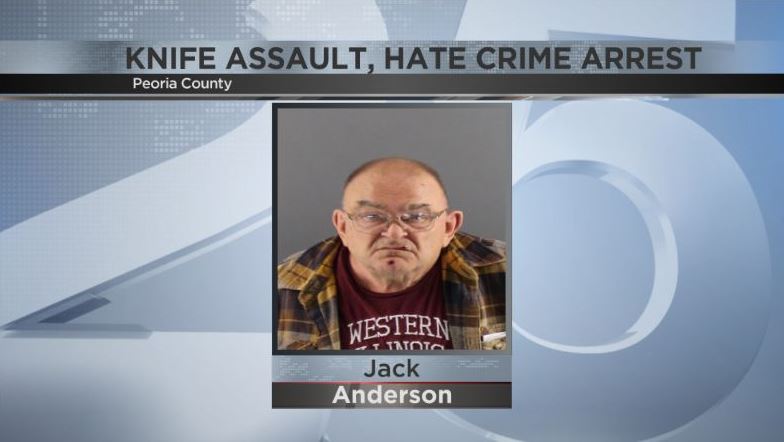
. . .
Even I was involved in an incident that questioned the racist tendencies of Peoria’s criminal justice system. In May of 2018, I was brutally assaulted by a violent white supremacist biker sporting a Confederate Flag on his leather jacket at the Circle K in the East Bluff. When I calmly informed him the Confederates were traitors, losers, and racists, Ralph Verneal Martin41 proceeded to strangle me. Faced with no other choice, I was forced to defend myself knocking Martin flat on the concrete (I’m normally a pacifist, but when forced to defend myself, I’m reluctantly willing to pass-a-fist). Yet, when PPD arrived on the scene, they arrested me and charged me with battery. Instead of doing a mere five minutes of investigatory work and actually reviewing the video tape from the gas station,42 PPD took the word of a gang of white supremacists. I had at least one witness who spoke in my defense. His testimony was not recorded in the incident report, and the witness stated the police & white supremacist bikers were very “buddy, buddy.”

The insanity doesn’t end there. When Peoria State’s Attorney Jerry Brady reviewed the case, he decided to double down and charge me with a felony. When I went in front of Judge Lyons (yes, the same Lyons as above), he refused to grant me my 6th amendment right to an attorney despite my indigence because of a disability. I was forced to spend several thousand dollars on an attorney (a feat I was only able to accomplish through the extremely generous donations of my many supporters). Months after the initial incident, the States Attorney finally bothered to do their job and review the video tape from the gas station. All charges were quickly dropped. Who knows how much money Peoria county wasted pursuing bogus charges and protecting violent white supremacists.
. . .
After examples like the above, it’s worth asking just what the hell is going on at the Peoria County State’s Attorney office. I’m reticent to call people with unconscious racial biases white supremacists (I didn’t even think Beth Akeson was a white supremacist despite her problematic beliefs), but I’m seriously beginning to wonder the allegiances of the those at the State’s Attorneys office. There are very few people of color currently working at the state’s attorney’s office, and according to Peoria State’s Attorney candidate Chris McCall (whose interview will appear in part 4 of this series), many lawyers of color have left the Peoria State’s Attorney office because of “lack of opportunities”. Without a doubt, there are serious and very real issues of racial inequity at the State’s Attorney’s office under both Jerry Brady and Kevin Lyons; inequities the office has been largely unwilling to address.
In Part 3, we will examine immigration and the influence of xenophobia in systemic racism in Peoria.
For more Fragments on Playing in Peoria, see here.
Does Systemic Racism Play in Peoria?
Part 1
The answer to this question is obvious. There’s been a deluge of evidence showing the systemic inequalities in the Peoria area.
In 2015, Peoria was ranked the 6th worst city in the U.S. for black people by 24/7 Wall St.
“The poverty rate of 28.2% among the city’s black population is well above the poverty rate among the city’s white residents of 10.4%. Similarly, the median annual income of $58,563 for white households is more than double the annual income of $28,777 for a typical black household.”
24/7 Wall Street
In 2016, Peoria was ranked the number one worst city in the U.S. for black people by 24/7 Wall Street.
“Black members of the workforce are far more likely to face difficulty in finding a job than their white counterparts. The black unemployment rate in the metro area is 15.3% compared to a 5.4% white unemployment rate. High incarceration rates also play a considerable role in contributing to regional inequality. Black Peoria residents are nearly nine times more likely to be incarcerated than white residents.”
24/7 Wall Street
In 2017, Peoria was ranked the 2nd worst city in the U.S. for black people by 24/7 Wall Street.
“The typical black household in the Peoria metro area earns just 43 cents for every dollar a typical white household earns, one of the largest black-white earnings gaps of any city. Differences in income are partially responsible for the large poverty gap in Peoria. While just 8.6% of white residents live below the poverty line, 35.2% of black residents in the city do… The difference in age-adjusted mortality rates of black and white residents in Peoria is one of the largest in the country.”
24/7 Wall Street
In 2018, 24/7 Wall Street ranked Peoria as the 5th worst city for black Americans.
“Peoria, Illinois, is one of many cities on this list with a long history of segregation, the effects of which linger today. Black Peoria residents are much more likely to struggle financially and far more likely to face difficulty finding employment than white Peoria residents. The metro area’s black poverty rate is 37.0% — higher than the national black poverty rate of 26.2% and well above the metro area’s white poverty rate of 9.2%. Additionally, 17.9% of the metro area’s black labor force is out of a job compared to a white unemployment rate of just 5.6%.”
24/7 Wall Street
in 2018, the 17th Congressional District was listed as the 3rd worst district for black Americans by 24/7 Wall Street. The representative for the 17th district is Democrat Cheri Bustos, a centrist with a terrible record against holding President Trump accountable. She has repeatedly voted to authorize the overreaching surveillance and military powers to Trump, voted against accepting Syrian refugees, refuses to support a Medicare 4 All plan, and has done little to address racial inequalities in this country.
“Currently, the typical black household in the district has an income of just $25,840 a year, about half the income of $51,047 of the typical white household. The black unemployment rate in the district of 21.6% is also nearly four times the white unemployment rate of 6.6%.”
24/7 Wall Street
In 2019, Governing magazine named the Peoria area schools one of the most segregated in the country.
“The city of Peoria has its own school district, a chronically troubled system with a declining enrollment that serves mostly black students. About 70 percent are low-income. White families have been avoiding the troubles of the inner-city school district by moving to the northern part of town, where they can send their kids to Dunlap instead… The Peoria area, in fact, has the most segregated public schools among black and white students of any metropolitan area in the nation, according to a Governing anaylsis of federal enrollment data. The region’s schools are more divided by race than those in metropolitan Boston, Detroit or Little Rock, all of which have been major battlegrounds in fights over school integration.”
Governing
Furthermore, Governing magazine also designated Peoria one of the most segregated cities in the country.
“Through unspoken traditions and ingrained attitudes, as well as explicit government actions, city officials are in many ways responsible for maintaining a system that still divides whites and blacks. When it comes to land use — what gets built where — governments use zoning restrictions to keep out rental housing, which attracts blacks and other minorities, from predominantly white areas. They approve new residential subdivisions with strict deed restrictions that make large swaths of communities unaffordable to low-income residents and often explicitly bar any use other than single-family homes. As they restrict where apartments can be built, local governments also play a big role in deciding where public housing and other taxpayer-supported affordable housing projects are located. That often leads to concentrated areas of low-income housing in black neighborhoods. Those changes almost inevitably become permanent, because the income restrictions and other rules that come with public subsidies last for decades.”
Governing
“In Peoria, the Illinois River is a 900-foot-wide chasm between poverty and prosperity. On one bank is the city of East Peoria, which is 92 percent white, with big-box retail stores including Costco, Target and a Bass Pro Shop just a stone’s throw from the river. On the west bank is the city of Peoria itself, just 57 percent white and becoming less so every year. There, the riverfront features the Taft Homes, rows of barracks built after the Korean War that are now used as public housing, despite efforts to replace them. Farther south, one ZIP code on Peoria’s southwest side — 61605 — has become local shorthand for urban blight. It’s about 58 percent black, with a poverty rate of 44 percent and an unemployment rate of about 20 percent as of a few years ago.”
According to At-Large Councilmember Dr. Rita Ali, a black man on the Southside of Peoria will live ten years less than a person that lives in the north part of the City.23
“Capitalism only can thrive if there is an amount of poverty and those at the bottom of the food chain are usually people of color,” said Pastor Marvin Hightower, President of the Peoria NAACP. And while the solution may not be pretty, ”it’s gonna take being comfortable with being uncomfortable.”28
Peoria City Council has attempted to address the issue of systemic racism. In 2017, they held a number of community meetings on race to address the issue. According to Pastor Marvin Hightower, President of the local NAACP, “The talks that were held focused on problems but didn’t really deal with the issue of racism,” he said.30 My grandmother and I attended the second community meeting held at the Peoria Civic Center. Tables were set up with each one having a city employee to facilitate conversation. They asked us to write down things we thought could help address the racial issues facing the city. I recommended an elected Police Review Board with the power and funding to investigate and punish bad PPD behavior if necessary. The City employee at our table (unbeknownst to me) was none other than Police Chief Jerry Mitchell (now retired). He pointed to my recommendation and flat out declared that would never happen. Incensed, I challenged him on why he felt the police should not be held accountable to the people. He replied that if individuals had an issue with PPD, they could direct the concern to him. He then left the table and instructed one of the cameramen to take photos of me, likely for some nefarious purpose.
In the election for At-Large city council seats this year, there were three African-Americans who made it to the general election: Dr. Rita Ali, Andre W. Allen, and Aaron Chess. Dr. Ali is also the Vice-President of Diversity at Illinois Central College, and she brought a wide range of experience in fighting for racial equity to the table. The most outspoken voice for racial equity was caucasian Peter Kobak. You’d be hard-pressed to find a single candidate forum where Kobak wasn’t forcefully demanding Peoria take personal responsibility for its legacy of racial inequality, and he came strapped with a list of policy proposals to address these important issues. Kobak’s passion for racial justice was so strong, Dr. Ali publicly gave him praise on his willingness to address these issues. One African-American candidate told me in private, that while they agreed with everything Kobak said and proposed on racial justice, they themselves felt if they came out as strongly on this issue as Kobak, they feared being labeled a radical revolutionary and risked turning off more moderate voters.
Dr. Ali was the one African-American candidate to win a seat on city council. She joins conservative financier Denise Moore (District 1) as the only two black members on Peoria City Council. Allen came in sixth behind conservative capitalist Sid Ruckriegal, losing by a mere 408 votes but cementing his political viability nonetheless. Aaron Chess came in last.
However, not everyone on city council is as convinced that systemic racism is an issue in Peoria. John “Mr. Growth™” Kelly repeatedly expressed his extreme skepticism that institutional racism was even real, often condescendingly ignoring the claims of black Peorians. Our alleged servant-leader, Zach Oyler, while more tactful than Mr. Growth™, was also doubtful about the governments ability to address racial inequalities. He stated multiple times that local government is really only for fixing infrastructure and providing Fire/Safety to the town. Of course, when we talk about institutional racism, the very institutions we are referring to are often–though not always–government entities. And city council has done little but grant lip service to addressing this issues. They held the various community forums on the issue, hired a diversity officer for the city, passed purely symbolic resolutions against Islamophobia and for a Welcoming City but resolutions functionally do little.
In Part 2, we’ll examine the Peoria police and state’s attorney’s role in contributing to systemic racism.
For more Fragments on Playing in Peoria, see here.
Philosophical Foundations for Race
In this paper, I will describe how the concept “race” was formed starting in the early 17th century. First, I will briefly explain what race is and what it is not. Then, I will look at the connections between white privilege and Lockean theories of property in the 17th century. Next, I will look at Kant and his theories regarding a biological conception of race, as well as the effects circumscribed into law and society. Finally, I will analyze J.S. Mill’s ideas concerning colonization and the current impacts on society. While this paper will analyze thinkers outside of an American context, I will be describing race from an American viewpoint… (view more)

